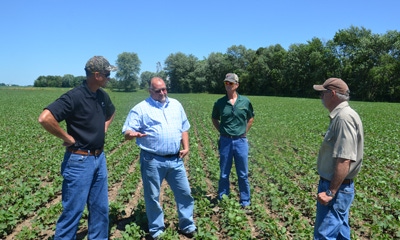
Ask a retail chemical dealer to find a field to show what a product can do, and he or she will likely pick one where they know there has been weed pressure in the past. After all, they want to see what the herbicide can do, too. Any herbicide program can look good if weed pressure in the field is limited in the first place.
When asked by a chemical company to put a product to the test, Mark Rossok, assistant manager of the Co-Alliance outlet in Russellville, picked a field where he knew there was significant weed pressure. The field was covered with manure in the past, and Palmer amaranth had been identified there before. He knew there was no shortage of giant ragweed there, either.

EVALUATE CONTROL: Evaluating this field are (from left) Bill Johnson, Purdue University; Dale Stouffer, Monsanto; Dan Childs, Monsanto; and Mark Rossok, Co-Alliance.
The herbicides Monsanto’s Dan Childs wanted Rossok to evaluate were Warrant and Warrant Ultra, which can be applied preemergence or postemergence on soybeans. Rossok says 64 ounces of Warrant plus 6 ounces of Dimetric per acre were applied at planting. Three weeks later, Co-Alliance applied 60 ounces of Warrant Ultra per acre, primarily to stop giant ragweed escapes.
A couple of weeks after spraying, Childs did an exclusive interview standing in the field, viewing the results. Childs is a weed management tech representative with Monsanto.
IPF: Why was Warrant a good choice for this field?
Childs: It has residual activity and is very good on many weeds. It can pick up Palmer amaranth, and it works really well on marestail when applied at the right stage.
IPF: Does it control giant ragweed?
Childs: It provides very good control of small-seeded broadleaves and grasses when applied as a residual herbicide. You may need to add something to help it on large-seeded broadleaves, like giant ragweed.
IPF: What are possible additions?
Childs: Sencor is one possibility. It is older triazine chemistry but works well in many cases, and has dropped in price recently. It picks up those big-seeded broadleaf weeds.
IPF: Do Warrant or Warrant Ultra control the same weeds if applied postemerge as if applied preemerge?
Childs: It won’t pick up grass as well postemerge, because the ingredient that controls grass is a residual. If you were going to apply it post and had emerged grass, add something with it to pick up the grass species.
IPF: What else should a farmer know about these herbicides?
Childs: Warrant is an encapsulated product. It is a formulation that is delivering good, consistent results.
IPF: So is it intended to be a stand-alone product or one used as part of a system?
Childs: We very much believe in a systems approach. We need that residual herbicide to help get a good base of control. Results like those in this field indicate that Warrant and/or Warrant Ultra can deliver a good base of control. You’re always going to have a few escapes for various reasons, and you need to figure out why those are there. Overall, though, we see this as part of a good systematic approach to weed control.
About the Author(s)
You May Also Like




